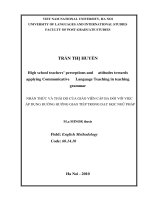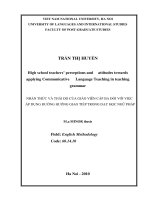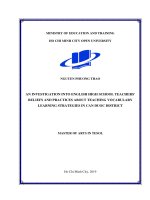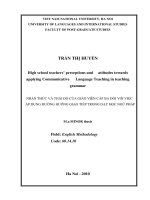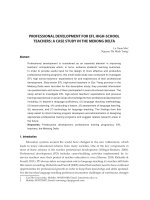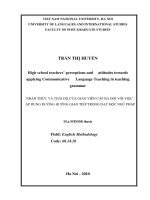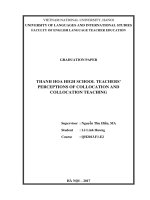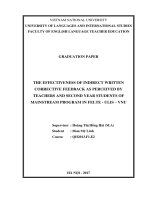Written corrective feedback efl high school teachers perceptions and practices
Bạn đang xem bản rút gọn của tài liệu. Xem và tải ngay bản đầy đủ của tài liệu tại đây (1.98 MB, 159 trang )
MINISTRY OF EDUCATION AND TRAINING
QUY NHON UNIVERSITY
NGUYEN THI THUY KIEU
WRITTEN CORRECTIVE FEEDBACK:
EFL HIGH SCHOOL
TEACHERS’ PERCEPTIONS AND PRACTICES
Field: Theory and Methodology of English Language Teaching
Code: 8140111
Supervisor: Assoc.Prof. Dr. Nguyen Thi Thu Hien
BỘ GIÁO DỤC VÀ ĐÀO TẠO
TRƯỜNG ĐẠI HỌC QUY NHƠN
NGUYỄN THỊ THÚY KIỀU
PHẢN HỒI SỬA LỖI BÀI VIẾT: NHẬN THỨC VÀ
THỰC HÀNH CỦA GIÁO VIÊN CẤP THPT
Ngành: Lý Luận và Phương Pháp dạy học bộ môn Tiếng Anh
Mã số: 8140111
Người hướng dẫn: PGS. TS. Nguyễn Thị Thu Hiền
i
STATEMENT OF AUTHORSHIP
I hereby declare that I am the sole author of this master thesis and that I
have not used any sources other than those listed in the bibliography and
identified as references. I further declare that I have not submitted this thesis
for any degree at any other university or tertiary institution.
Quy Nhon, 2023
Nguyễn Thị Thúy Kiều
ii
ACKNOWLEDGEMENTS
The completion of this thesis would not have been possible without the
guidance and support of numerous people who devoted themselves to helping
me, placed belief in me, and motivated me to pursue the ultimate goal. I would
like to take this chance to express my sincere gratitude to all those involved.
My most profound appreciation goes to my supervisor, Assoc. Prof. Dr.
Nguyen Thi Thu Hien, for her time, effort, and understanding in helping me
succeed during my academic work. Her vast wisdom and wealth of experience
have inspired me throughout my studies. I feel fortunate to have had her support
my work.
In addition, I would like to express my heartfelt appreciation to the
professors, lecturers, and instructors of Quy Nhon University for their thoughtful
and patient support in imparting priceless knowledge and accompanying me with
the steps fundamental to finishing my degree program.
My sincere gratitude also goes out to the high school English teachers in
central regions and central highland provinces for their helpful contribution and
collaboration in this study.
I am also grateful to the school administrators and my colleagues at Tran
Hung Dao High School, Mang Yang, Gia Lai for their sympathy and support
during my study time.
Last but not least, I am gratefully indebted to my family and friends who
have accompanied me on this journey. Their unwavering support and
encouragement throughout my course truly gave me strength and served as a
fantastic source of inspiration.
iii
ABSTRACT
This study aims to investigate two key issues: (1) teachers’ perceptions
of their WCF practices and (2) their actual practices in a Vietnamese EFL
context. The data was collected from multiple sources including a
questionnaire with 65 English high school teachers in central and central
highland provinces in Vietnam, interviews with 10 of those who had
completed the questionnaire before, and 937 WCF points detected from 150
students’ writing texts with teacher WCF. The findings of the study revealed
that (1) the teachers’ perceptions regarding WCF provision were
overwhelmingly favourable. They believed that WCF was essential for high
school students’ EFL writing development and served multiple purposes. In
terms of their self-reported practices of WCF, the teachers preferred selective
over comprehensive WCF; they also favoured both direct and indirect
feedback strategies, primarily focused on language forms when provided the
students’ writing with correction feedback. (2) As regards the teachers’ actual
practices of WCF in their writing classrooms, they predominantly employed a
comprehensive approach, and direct feedback strategy to give correction
feedback mainly on language forms to the student’s writing errors. (3) A
degree of congruence and incongruence between teachers’ perceptions and
practices of WCF in certain areas were also discussed. This misalignment
calls for professional training in teaching writing in general and addressing
WCF in particular to ensure the effectiveness of WCF strategies employed by
teachers. The results of this study also imply that the teachers and their
students should cooperate to reach the ultimate goals of WCF.
Key terms: EFL teachers, error correction, teacher perceptions,
teacher practices, Written Corrective Feedback
iv
TABLE OF CONTENTS
STATEMENT OF AUTHORSHIP ......................................................................i
ACKNOWLEDGEMENTS ................................................................................. ii
ABSTRACT ........................................................................................................ iii
LIST OF ABBREVIATIONS ............................................................................vii
LIST OF TABLES ............................................................................................ viii
LIST OF FIGURES.............................................................................................ix
CHAPTER 1. INTRODUCTION ....................................................................... 1
1.1. Rationale.....................................................................................................1
1.2. Aim and Objectives....................................................................................5
1.3. Research Questions....................................................................................5
1.4. Scope of the Study......................................................................................5
1.5. Significance of the Study...........................................................................6
1.6. Organization of the Study.........................................................................6
CHAPTER 2. LITERATURE REVIEW ........................................................... 8
2.1. Teachers’ Perceptions and Practices ........................................................8
2.1.1. Concepts of Perceptions ........................................................................8
2.1.2. Importance of Studying Perceptions and Practices............................9
2.1.3. Relationship Between Teachers’ Perceptions and Their Practices in
Classrooms .................................................................................................... 10
2.2. Written Corrective Feedback in L2 Writing.........................................11
2.2.1. Definitions of Written Corrective Feedback ..................................... 11
2.2.2. Purposes of Written Corrective Feedback.........................................13
2.2.3. Types of Written Corrective Feedback and Teachers’ Preferences..14
2.2.3.1. Types of Written Corrective Feedback.....................................15
2.2.3.2. Teachers’ preferences for Written Corrective Feedback types.
................................................................................................................... 18
2.2.4. Strategies for Providing Written Corrective Feedback .....................21
2.2.4.1. Direct Written Corrective Feedback. .......................................22
v
2.2.4.2. Indirect Written Corrective Feedback. ....................................23
2.2.4.3. Metalinguistic Written Corrective Feedback. .........................25
2.2.4.4. Focused Versus Unfocused CF...................................................27
2.2.4.5. Electronic Feedback. ..................................................................28
2.2.4.6. Reformulation. ............................................................................28
2.3. Previous Studies on Teachers’ Perceptions and Practices Regarding
Written Corrective Feedback ........................................................................29
2.4. Chapter Summary ...................................................................................32
CHAPTER 3. METHODOLOGY ....................................................................33
3.1. Research Design .......................................................................................33
3.2. Research Setting and Participants .........................................................34
3.3. Research Instruments..............................................................................37
3.3.1. Questionnaire .....................................................................................37
3.3.2. Semi-structured Interviews ................................................................38
3.3.3. Students’ Writing Samples .................................................................39
3.4. Data Collection.........................................................................................40
3.5. Data Analysis............................................................................................43
3.6. Research Reliability and Validity ...........................................................45
3.7. Ethical Considerations ............................................................................48
3.8. Chapter Summary ...................................................................................48
CHAPTER 4. FINDINGS AND DISCUSSION...............................................49
4.1. Findings ....................................................................................................49
4.1.1. Teachers’ Perceptions of Written Corrective Feedback....................50
4.1.1.1. Teachers’ Perceptions of the Main Purpose of WCF Provision.
................................................................................................................... 50
4.1.1.2. Teachers’ Evaluation of the Effectiveness of Their WCF
Practices on Their Students’ Writing. ...................................................52
4.1.1.3. Teachers’ Perceptions of WCF Strategy Practices. ................54
4.1.1.4. Teachers’ Perceptions of WCF Techniques. .............................60
4.1.2. Teachers’ Practices of Written Corrective Feedback ........................67
4.1.2.1. Types of Written Corrective Feedback.....................................67
vi
4.1.2.2. Strategies for Providing Written Corrective Feedback. .........75
4.2. Discussion .................................................................................................81
4.2.1. Teachers’ Perceptions of Written Corrective Feedback....................81
4.2.2. Teachers’ Practices of Written Corrective Feedback ........................86
4.2.3. Teachers’ Perceptions and Their Actual Classroom Practices
Regarding Written Corrective Feedback .....................................................91
4.2.3.1. WCF Efficacy and Responsibility. ............................................91
4.2.3.2. Using Marking Codes.................................................................92
4.2.3.3. The Amount of WCF. .................................................................93
4.2.3.4. The Focus of WCF. .....................................................................95
4.2.3.5. The Strategies for WCF..............................................................95
CHAPTER 5. CONCLUSION ..........................................................................98
5.1. Summary of the Findings........................................................................98
5.2. Pedagogical Implications for the Teaching and Learning Process ...101
5.3. Limitations of the Study........................................................................102
5.4. Recommendations for Further Research ............................................103
REFERENCES .................................................................................................105
APPENDICES ............................................................................................... AP-1
APPENDIX A1. QUESTIONNAIRE (ENGLISH VERSION).............. AP-1
APPENDIX A2. QUESTIONNAIRE (VIETNAMESE VERSION) ..... AP-5
APPENDIX B1. INTERVIEW QUESTIONS (ENGLISH VERSION).. AP-
10
APPENDIX B2. INTERVIEW QUESTIONS (VIETNAMESE VERSION)
................................................................................................................... AP-11
APPENDIX C1. TRANSCRIPTION OF THE INTERVIEW
QUESTIONS (ENGLISH VERSION)................................................... AP-13
APPENDIX C2. TRANSCRIPTION OF THE INTERVIEW
QUESTIONS (VIETNAMESE VERSION) .......................................... AP-19
vii
LIST OF ABBREVIATIONS
CF Corrective Feedback
EFL English as a Foreign Language
ESL English as a Second Language
L2 Second Language
SLA Second Language Acquisition
WCF Written Corrective Feedback
viii
LIST OF TABLES
Table 2.1 Elements in Writing ......................................................................... 18
Table 2.2 Strategies for Providing CF ............................................................ 21
Table 3.1 Demographic Information of Participants...................................... 35
Table 3.2 Description of Examining Students’ Writing Texts .......................... 44
Table 3.3 Reliability Statistics of 9 Likert Scale Questions ........................... 46
Table 3.4 Item-total Statistics.......................................................................... 46
Table 4.1 Teachers’ Perceptions of the Main Purpose of WCF ...................... 50
Table 4.2 Teachers’ Self-evaluation of the Effectiveness of Their WCF
Practices on Their Students’ Writing .............................................................. 52
Table 4.3 Teachers’ Perceptions of Their WCF Strategies ............................. 54
Table 4.4 Teachers’ Description of Their Existing Feedback Practices ......... 61
Table 4.5 Frequency of WCF Techniques Provided by Teachers.................... 62
Table 4.6 Amount of WCF Provided by the Teachers on the Students’ Writing
......................................................................................................................... 70
Table 4.7 Focus of WCF Provided by EFL High School Teachers................. 74
Table 4.8 Strategies for WCF Provided by EFL High School Teachers ......... 80
ix
LIST OF FIGURES
Figure 4.1 Teachers’ Perceptions of Using Marking Codes ........................... 59
Figure 4.2 Frequency of WCF Techniques Provided by Teachers .................. 65
Figure 4.3 Sample of Teacher WCF on Student Writing ................................. 68
Figure 4.4 Sample of Teacher WCF on Student Writing ................................. 69
Figure 4.5 Sample of Teacher WCF on Student Writing ................................. 71
Figure 4.6 Sample of Teacher WCF on Student Writing ................................. 72
Figure 4.7 Sample of Teacher WCF on Student Writing ................................. 73
Figure 4.8 Sample of Teacher WCF on Student Writing ................................. 76
Figure 4.9 Sample of Teacher WCF on Student Writing ................................. 77
Figure 4.10 Sample of Teacher WCF on Student Writing ............................... 78
Figure 4.11 Sample of Teacher WCF on Student Writing ............................... 79
1
CHAPTER 1. INTRODUCTION
1.1. Rationale
Teaching and learning English in Vietnam aims to help students
develop both oral and written communication. Along with speaking, writing
skill is also an important aspect of communication because it enables people
to express their thoughts, feelings, and opinions. Even though writing is
essential and valuable for students, as compared to other skills such as
reading, listening, and speaking, many students believe that it is challenging
to master writing skills due to the great number of language elements
involved (Harmer, 2004). In line with this, Ly (1997) stated that as a matter of
fact, many Vietnamese students are more motivated to develop speaking,
reading, and listening abilities than writing, and writing appears to be seen as
a hardship because there is always homework waiting for them after a writing
lesson. To illustrate this skill’s complicity, Hedge (1988) explained that
writing typically calls for a variety of skills, including the capacity to generate
ideas and information, a high level of correctness to prevent
misunderstandings among readers, and the use of a wide range of grammatical
structures, syntax, and vocabulary. All of them contribute to developing a
specific writing style that aligns with the writing theme and the intended
audience. It is writing that those who learn English as a foreign language find
the most complex and challenging to learn because “writing is an extremely
complex cognitive activity for which the writer is required to demonstrate
control of several variables simultaneously” (Nunan, 1989).
Upon learning writing skills, for novice students, making mistakes is an
unavoidable and natural aspect of development. Teachers' Written Corrective
Feedback (WCF) to students' mistakes in this situation is crucial in assisting
2
them in enhancing their written correctness so they can effortlessly advance to
a higher language level. WCF sometimes known as grammar or error
correction has long been standard practice for teachers to provide in L2
education. In reality, second language learners continue to make a variety of
mistakes despite the time and effort their teachers put into providing
feedback. Thus, critics of mistake correction, including Truscott (1996),
voiced their concerns and even called for its removal from L2 writing courses.
This drew instant attention and sparked frank debates among L2 scholars. As
a crucial component of L2 writing instruction, over the last decades, a notable
corpus of empirical studies has been carried out to look into the function of
WCF in SLA and L2 writing. The vast majority of recent better-designed
research has produced favourable outcomes for WCF (Bitchener, 2008, 2009;
Bitchener et al., 2005; Ellis et al., 2008; Le, 2014; Sheen et al., 2009).
Besides, many studies focus on students' views of teachers’ WCF, or teachers’
perceptions of WCF (Saragih et al., 2021; Eriksson, 2022; Zohra & Fatiha,
2022; Mi, 2020; Nguyen et al., 2021). However, only a few studies have
examined how instructors implement WCF, and the alignment of teachers'
perceptions and practices (Lee, 2009; Sakrak-Ekin & Balgikanli, 2019;
Purnomo et al., 2021). This, of course, calls attention to teachers’ perceptions
and practices towards WCF in the EFL context.
Borg (2003) indicated that teachers’ theories and perceptions have a
great effect on their actual teaching practices. By the same token, Squires &
Bliss (2004), asserted that “decades of research on the connection between
teachers’ theoretical beliefs and their practices yield a common theme: all
teachers bring to the classroom some level of beliefs that influence their
critical decision making.” Indeed, it can not be denied that teachers’ beliefs,
practices and attitudes play a crucial part in understanding and improving
3
teaching and learning processes. They are definitely associated with teachers’
strategies for facing obstacles in their daily professional lives. Subsequently,
they influence student inspiration and achievement while modifying the
learning environment for students. Teachers also require new thinking skills,
such as large picture, transdisciplinary, simulation, design, and computational
forms of reasoning, in order to handle many aspects of issues in more
complex educational environments. Importantly, instructors must be
conscious of their perceptions and beliefs, be motivated to achieve their plans
and goals and be inspired to create creative pedagogies to advance their
profession. (Woon Chia & Goh, 2016). Teachers’ beliefs and practices are
crucial in the classroom because they directly affect the process of teaching
and learning (Griffiths, 2007). On the grounds that providing feedback is such
a difficult yet crucial responsibility for teachers. Discovering the perceptions
that support instructors' practices can assist in discovering the elements that
lead to beneficial feedback. This explains why the current investigation was
conducted.
Academic achievement for EFL students depends on their ability to
write. Nonetheless, after serving as the writing course teacher at a high school
in the central highland region for fifteen years, I found that students were
failing to meet the course's planned writing assessment goals. Additionally, I
recognised that students struggled during the writing course. It was normal to
find a large number of students who had trouble writing well-organized
paragraphs and compositions or even some meaningful, grammatically sound
sentences. One possible reason for this is that writing teachers prioritize the
final product over the writing process and its social context (Chi, 2022). The
teachers pay more attention to form than meaning. In other words, they focus
on the textual or linguistic elements of writing without considering the text's
4
purpose and audience. Another reason can be teachers' unsuitable feedback on
students' writing. They seem to provide little or ineffective feedback, which
may be based on their prior teaching experience and personal perspectives
when it comes to the appropriate way to evaluate students' writing, as opposed
to according to a department-wide standard WCF policy. Teachers rarely
ponder the kinds of feedback that are appropriate for the students or whether
the feedback will benefit the students' writing. As a result, it was challenging
for the pupils to reply to the teachers’ remarks (Mack, 2009). If teachers'
WCF contains ambiguous remarks or marks mistakes inconsistently, it may
have a poor impact on learners' writing skills, leading to frustration, passivity,
and confusion (William, 2003).
However, little consideration has been given to the attitudes and
perspectives of teachers or how they conceptualized teaching writing, which
is crucial for comprehending the causes of teachers' improper WCF practices
and developing pedagogical reforms. If teachers can carry out instructions in
line with their beliefs, it appears that the presence of contextual factors, such
as institution requirements, curriculum mandates, examination influence, and
student's needs and preferences, is crucial (Feryok, 2008). Exploring the
hurdles that prevent teachers from putting their beliefs into practice and
determining how teachers' beliefs about WCF are reflected in their practices
serve as essential areas for further research.
It has been extensively observed that teachers' attitudes about language
learning and teaching influence the way they instruct their students. Even though
major efforts have been made to study many various aspects of L2 teaching from
a teacher-belief perspective in foreign countries, there have only been a few
studies looking at teachers' views in the context of EFL high schools in Vietnam.
What is more, in terms of the area of the study in the Vietnam context, only
5
some studies are found in the tertiary context, focusing mainly on one type of
participants-students (Ho et al., 2020; Nguyen et al., 2022; Nguyen et al., 2021).
In light of the need to understand teachers' perceptions and actual practices, the
knowledge gap in the research area as well as the issue present in the context, the
researcher is interested in investigating to learn what EFL teachers perceive and
apply WCF in writing classes.
1.2. Aim and Objectives
The overarching aim of this study is to investigate teachers' perceptions
and practices towards WCF in the context of central and central highland
regions' high schools. Its further objectives are elaborated upon as follows:
1. To find out the perceptions of teachers concerning WCF
2. To explore teachers’ actual classroom practices of WCF.
1.3. Research Questions
The study attempts to provide answers to the following research
questions in order to achieve the aforementioned objectives:
1. What perceptions do EFL high school teachers hold regarding
written corrective feedback?
2. What are EFL high school teachers’ practices of written
corrective feedback?
1.4. Scope of the Study
The scope of the study focuses on exploring teachers’ perceptions of
WCF and their current classroom practices. The study specifically finds out
teachers' general perceptions of the effects of WCF. Besides, their practices of
WCF in writing classrooms are extensively investigated. The findings may
demonstrate the (mis)alignments between WCF perceptions and practices. Due
to the limitations of time, ability, and data availability, the empirical study in this
6
research is restricted to high schools located in central and central highland
regions of Vietnam, where the opinions of 65 teachers in the survey and 10
teachers in interview sessions are studied. The respondents in the study,
therefore, may not be representative of all teachers in middle and central
highland provinces in particular and all English teachers nationwide in general.
1.5. Significance of the Study
In contrast to the bulk of feedback research, which covers the ESL
higher education context, this study concentrates on the upper-secondary EFL
setting in Vietnam and thus contributes to the current feedback-based
research. In other words, its importance comes from shedding light on a
phenomenon from the perspectives of its participants in a certain context. The
results will paint a clearer and more comprehensive picture of the correlation
between teachers' WCF perceptions and practices. Besides the theoretical
ramifications that the findings of the study provide, pedagogical significance
for practitioners such as English teachers, students, and researchers is
involved. Pedagogically, on the one hand, EFL instructors can broaden their
understanding of the many types of feedback strategies and apply them in
their instruction. On the other hand, to improve the effectiveness of the
teaching and learning process, teachers can modify the manner they provide
feedback. The study is meant to increase understanding of the significance of
teachers' Corrective Feedback (CF) in boosting language proficiency in
learners. Students can utilize WCF to its fullest potential in their English
learning by acknowledging its importance. Finally, especially in the context
of EFL Vietnamese education, this can assist in establishing the groundwork
for more research on the same topic.
1.6. Organization of the Study
This study is organized as follows:
7
Chapter 1 functions as an introduction to the thesis, including the
rationale, the aims and objectives, the research questions and the significance
of the study.
Chapter 2 presents the theoretical framework of the research, and
reviews the definitions of several key terms and significant prior studies
linked to the current research, followed by a description of the research gap
that the current study seeks to fulfil.
Chapter 3 discusses the research methodology and the procedure
involved in the project. It aims to describe the subjects, research instruments,
employed methods, data collection procedures, and data analysis applied to
conduct this study.
Chapter 4 provides a thorough presentation and analysis of the
collected data in order to address the research questions. The results of the
questionnaire's quantitative analysis and the descriptive transcripts' qualitative
analysis yield support for the research questions about teachers' perceptions
and practices. Feedback analysis of students’ writing papers addresses the
first question to explore teachers‘ actual practices of the use of WCF.
Chapter 5 outlines the research findings and discusses their theoretical
and practical implications. It also discusses the limitations of the study and
some recommendations for further research.
8
CHAPTER 2. LITERATURE REVIEW
The chapter reviews the literature pertinent to the topic from two
primary, interwoven perspectives. The first examines theoretically the
literature on teachers' perceptions and practices. The second is the literature
on WCF, with an emphasis on research on teacher perceptions, and teacher
actual practices. Finally, the chapter concludes by reviewing earlier research
in relation to this thesis to identify the research gap to be filled.
2.1. Teachers’ Perceptions and Practices
This part of literature review looks at three areas related to the issues of
teachers’ perceptions and practices. The first area presents the different
definitions of perceptions. The second area focuses on the importance of
studying teachers’ perceptions and practices. The last area examines the
nature of the relationship between teachers’ perceptions and practices in
classrooms.
2.1.1. Concepts of Perceptions
Perception plays an integral part in the process of teaching and
learning, and as such, it has been the subject of much research in the field of
pedagogy. It is described as the process of identifying and comprehending
things through the use of senses such as sight, hearing, touch, etc… (Richards
& Schmidt, 2013). Likewise, according to Robert et al. (1992), the five senses
are used to initiate the perceiving process to receive a stimulus; it is then
organized and interpreted to gain an understanding of what is perceived. The
way a person responds to an object that they perceive through their five
senses is known as perception. Therefore, in essence, perception is specific to
humans because it is how we as beings define or provide for the world around
9
us. Furthermore, the way one person perceives something will be radically
different from the way another person experiences it since perception is a
subjective process influenced by individual variances.
Feldman (1999) defined perception as the process of classifying,
evaluating, interpreting, and integrating the stimuli that involve our senses,
organs, and brain. In Kotler's (2000) words, the process by which a person
selects, arranges, and interprets the information inputs to create a substantive
overall notion is known as perception. Meanwhile, perception, according to
Morgan (1987), is the way something looks, sounds, feels, tastes, or smells.
Perception is often defined as whatever a person experiences. It can be
concluded that each person's perception is shaped by their experiences and
feelings. Each person's perception does not only occur spontaneously but is a
response brought about by the process of perceiving.
2.1.2. Importance of Studying Perceptions and Practices
Teachers' perceptions are the thoughts or mental pictures they have
about their work and pupils. These ideas and pictures are influenced by their
life experiences and prior knowledge, and they have an impact on how they
behave in the workplace (Papadakis & Kalogiannakis, 2020).
Teachers play a critical role in helping students build a great number
of competencies. To do their jobs effectively, teachers must be conscious of
their beliefs and perceptions, feel encouraged to attain their plans and goals
and be driven to create novel pedagogies to advance their practice. They must
also be able to successfully incorporate these learning objectives into the
courses they teach (Tan & Liu, 2015). In line with this, a variety of research
which focuses on teachers' perceptions, experiences, and learning has
demonstrated that teachers' perspectives on their jobs, the learning programs
they use, and other aspects of their lives can have a significant impact on the
